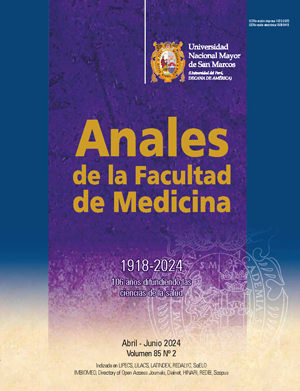Relationship between iron deficiency and microcytic anaemia factor in deferred blood donors
DOI:
https://doi.org/10.15381/anales.v85i2.27354Keywords:
Iron Deficiency, Blood Banks, Blood DonorsAbstract
Introduction: Beckman-Coulter hematology analyzers have used the Microcytic Anemia Factor (Maf®) as a simple and inexpensive screening tool for the early detection of iron deficiency (ID). Objective: to determine the relationship between iron deficiency and Maf® and evaluate the diagnostic performance in the detection of iron deficiency in deferred applicants for blood donation. Materials and Methods: Cross-sectional study. We reviewed 159 clinical histories of postulants to donate blood deferred for having hemoglobin values lower than 12.5 gr/dl (women) and lower than 13.5 gr/dl (men) who attended the Hemotherapy and Blood Bank Service of the Cayetano Heredia Hospital in Lima-Peru. ID was categorized with ferritin values ≤ 30 ng/ml. Maf® was calculated with data obtained from the blood count using the formula Maf® = ((Hemoglobin x Mean Corpuscular Volume) /100)). The Receiver Operating Characteristic Curve (ROC) with the area under the curve (AUC) was used to predict ID. Results: 45.5% of female participants presented iron deficiency. A statistically significant relationship was found between ID and Maf® (p<0.001). The ROC analysis for Maf® and the diagnosis of DH showed an AUC of 0.9174 with a cut-off point of 8.97 (sensitivity 90% and specificity 81.16%). Conclusions: A significant association was found between iron deficiency and Maf®. In addition, this parameter has a good performance to discriminate ID in deferred applicants to donate blood.
Downloads
Published
Issue
Section
License
Copyright (c) 2024 Alejandra Vargas, José Vega, Rubelio Cornejo, Christian Lezama, Rodrigo Paredes, Pedro Aro

This work is licensed under a Creative Commons Attribution-NonCommercial-ShareAlike 4.0 International License.
Those authors who have publications with this magazine accept the following terms:
- Authors will retain their copyrights and guarantee the journal the right of first publication of their work, which will be simultaneously subject to Creative Commons Attribution License that allows third parties to share the work as long as its author and its first publication this magazine are indicated.
- Authors may adopt other non-exclusive licensing agreements for the distribution of the version of the published work (eg, deposit it in an institutional electronic file or publish it in a monographic volume) provided that the initial publication in this magazine is indicated.
- Authors are allowed and recommended to disseminate their work over the Internet (eg: in institutional telematic archives or on their website) before and during the submission process, which It can produce interesting exchanges and increase quotes from the published work. (See El efecto del acceso abierto ).



